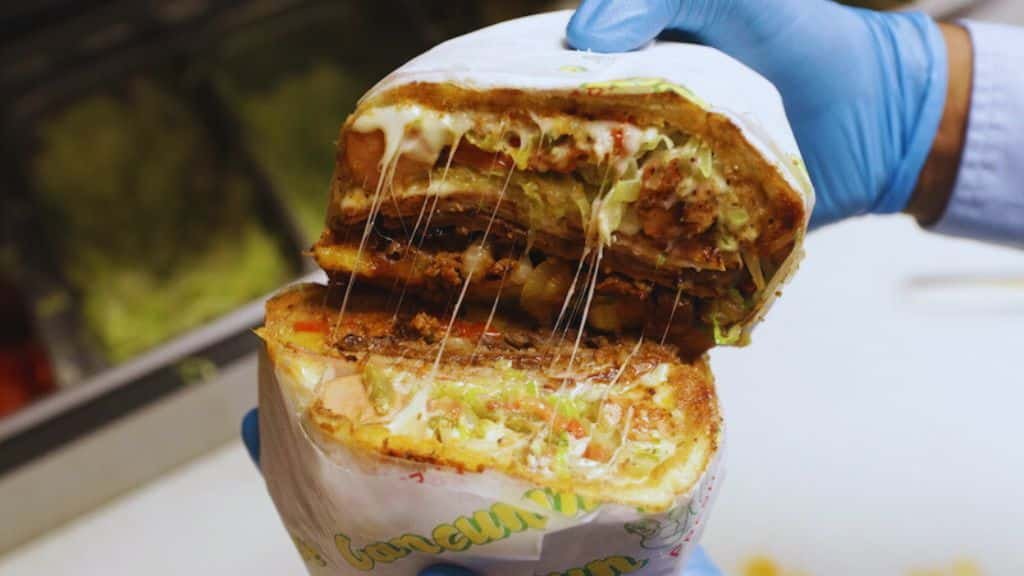The Torta Cubana is a traditional Mexican sandwich that is usually filled with various meats, including simple slices of jamón, roasted pork like carnitas, chorizo, and carne asada. Although tacos, burritos, and fajitas are more famously associated with Mexican cuisine, the Torta Cubana remains a highly favored dish in Mexico.
The torta cubana stands out as a quintessential element of Mexican street food, captivating both locals and visitors with its rich flavors and hearty ingredients. This iconic sandwich is more than just a meal; it’s a culinary adventure wrapped in a bolillo bun, offering a taste of Mexico’s vibrant food culture.
What Is a Torta Cubana?
The torta Cubana is a delightful Mexican sandwich originating from Calle Republica de Cuba in Mexico City, where it was first crafted. This sandwich is packed with an assortment of meats, cheeses, and sauces, making it rich in flavor. Depending on the region and the chef’s personal taste, the torta Cubana might include a variety of meats such as jamón, carnitas, chorizo, or carne asada, all tucked between slices of crusty bread that are pan-fried in butter until they reach a perfect crispness.
Similar to the torta Milanesa, which is filled with breaded steak, the torta Cubana layers its meat with a mix of refried beans, avocado, American-style cheese, and sometimes a chipotle-spiced crema. Although it shares a name with the Cubano, a Cuban sandwich featuring roasted pork, cheese, mustard, and pickles, the two are distinct, each beloved for their unique combinations of ingredients.
Related: Turkish Foods
History and Origin of Torta Cubana
The torta, a versatile and beloved sandwich, has a long-standing place in Mexican cuisine, but the torta cubana is unique among its peers. While the exact origins of its name remain a subject of culinary debate, the most popular theory suggests that its assortment of ingredients is as diverse as the Cuban culture, hence the name. Initially a working-class meal, it has transcended its humble beginnings to become a popular choice across various social strata.
In Mexico, the torta cubana is more than just a sandwich; it’s a staple at celebrations and a common quick meal option. It embodies the spirit of Mexican street food—diverse, flavorful, and unpretentious. Stories of late-night eateries serving warm tortas to lively crowds highlight its role in Mexico’s food scene.
What is a Torta Cubana Made of?
A Torta Cubana is a hearty and indulgent Mexican sandwich known for its generous assortment of fillings. At its core, the sandwich typically includes various types of meats such as jamón (ham), carnitas (slow-cooked pork), chorizo (spicy sausage), and carne asada (grilled beef). These are layered between slices of bolillo or telera, which are types of crusty white bread that are soft on the inside but provide a satisfying crunch when toasted.
The meat is complemented by rich layers of refried beans, slices of creamy avocado, and often a slice of American or Oaxaca cheese. It’s common to add a spicy element, such as chipotle sauce or jalapeños, to balance the richness of the meats and cheese. Altogether, these ingredients combine to create a filling, flavorful sandwich that is a beloved choice in Mexican street food cuisine.
READ: Lebanese Food
Key Ingredients
At its core, the torta cubana is a marvel of layering and flavor combination. Typical ingredients include:
- Bread: The foundation is usually a bolillo or telera, crusty on the outside and soft on the inside.
- Meats: A mix of thinly sliced ham, chorizo, and breaded pork cutlets.
- Cheese: A slice of melty Oaxaca or mozzarella cheese.
- Extras: Avocado slices, jalapeños, tomatoes, and refried beans, topped with a generous dollop of mayonnaise.
Step-by-Step Preparation
- Bread Preparation: Slice the bolillo or telera lengthwise without cutting through.
- Layering: Start with a spread of refried beans, followed by slices of ham, chorizo, and pork cutlets.
- Finishing Touches: Add cheese, slices of avocado, tomatoes, and jalapeños. Spread mayonnaise on the top half of the bread.
- Cooking: Grill the sandwich on a press or skillet until the bread is crispy and the cheese has melted, ensuring all flavors meld beautifully.
READ: Venezuelan Food
Variations of Torta Cubana

While the classic torta cubana is beloved, regional variations and dietary adaptations abound. Additional ingredients like eggs or different types of sausages are included in some areas. Vegetarian versions substitute meats with grilled vegetables or soy-based proteins, making the sandwich accessible to a broader audience.
A torta cubana is typically served hot and accompanied by pickled carrots or jalapeños. Some prefer to pair it with a cold beer or a refreshing agua fresca, enhancing the dining experience. Presentation-wise, the sandwich is usually cut diagonally, showcasing the layers of ingredients.
Nutritional Information
Given its generous fillings, the torta cubana is high in calories but also incredibly satisfying. It provides a substantial amount of protein and fats, with the avocado offering a healthy dose of monounsaturated fats.
READ: Nigerian Food
Torta Cubana vs Torta
.Here’s an informative table comparing the Torta Cubana with a generic Torta, highlighting key differences in ingredients, preparation, and cultural significance:
| Feature | Torta Cubana | Generic Torta |
| Origin | Named after Calle Republica de Cuba in Mexico City, where it was invented. | A general term for sandwiches in Mexican cuisine, with each type having its regional variations. |
| Bread Type | Typically uses bolillos or teleras, which are crusty on the outside and soft inside. | Can use a variety of breads including bolillos, teleras, or even baguettes, depending on the region. |
| Meats | Often includes a mix of jamón, carnitas, chorizo, and carne asada. | Varies widely; can include chicken, beef, pork, or even fish, tailored to regional tastes and traditions. |
| Additional Fillings | Commonly layered with refried beans, avocado, American-style cheese, and occasionally chipotle crema. | Fillings can include lettuce, tomato, onion, jalapeños, and different types of cheeses and sauces. |
| Cooking Method | Bread is typically pan-fried with butter until crispy. | Cooking methods can vary; some are grilled, others are served cold. |
| Cultural Significance | A specific sandwich known for its hearty and diverse filling, reflecting the bustling streets of Mexico City. | Represents the broad adaptability and diversity of Mexican street food, with each version reflecting local flavors. |
| Similar Sandwich | Often confused with the Cubano sandwich due to its name. | Each type of torta can have a counterpart in different cuisines, reflecting local adaptations. |
What’s the Difference Between Torta and Torta Cubana?
The term “torta” in Mexican cuisine broadly refers to any type of sandwich made with a variety of fillings and served on a specific type of bread, usually a bolillo or telera, which is known for its crusty exterior and soft interior. The fillings for a torta can vary greatly—from chicken, beef, and pork to vegetarian options, each tailored with regional ingredients and flavors. In contrast, the “Torta Cubana” is a specific kind of torta that is distinguished by its generous assortment of meats, including jamón, carnitas, chorizo, and carne asada, among others.
It also includes a rich layering of other ingredients like cheeses, avocados, and sometimes a spicy chipotle crema. While both sandwiches are staples of Mexican street food, the Torta Cubana is particularly notable for its hearty composition and its origins linked to a specific location in Mexico City, making it a distinct and beloved variant within the wider category of tortas.
READ: Armenian Food
Is Torta Spicy?
A Mexican torta is very similar to a sandwich, featuring a crusty roll that’s split and stuffed with an assortment of meats and other fillings. What sets a torta apart is its distinctly Mexican ingredients, which include a range of bold and spicy sauces and garnishes commonly used in various Mexican recipes.
Conclusion
The torta cubana is a testament to the creativity and richness of Mexican cuisine. With its bold flavors and satisfying texture, it invites food lovers to explore the depths of traditional Mexican cooking. Whether you make it at home or sample it on the streets of Mexico, the torta cubana promises a memorable culinary experience.
To Know More: Honduran Food
Frequently Asked Questions (FAQs) about the “Torta Cubana”:
What is a Torta Cubana?
A Torta Cubana is a popular Mexican sandwich made with a variety of meats such as jamón, carnitas, chorizo, and carne asada, usually served on a bolillo or telera bread with layers of cheese, avocado, and sometimes chipotle crema.
What kind of bread is used for a Torta Cubana?
The sandwich is typically made with either bolillo or telera bread. Both are crusty on the outside and soft on the inside, perfect for holding the sandwich’s hearty fillings.
What makes a Torta Cubana different from other tortas?
The distinguishing feature of a Torta Cubana is its combination of multiple types of meats, making it richer and more varied in flavor compared to other tortas, which might contain only one type of meat along with other fillings.
Is the Torta Cubana spicy?
The spiciness of a Torta Cubana can vary. While the sandwich itself isn’t inherently spicy, ingredients like chipotle crema or jalapeños can be added to give it a spicy kick.
Can a Torta Cubana be made vegetarian?
Yes, a vegetarian version can be made by substituting the meats with grilled vegetables, tofu, or other plant-based proteins, while still including traditional toppings like avocado and cheese.
Where can I find a Torta Cubana?
Torta Cubana can be found at many Mexican street food stalls, taquerias, and restaurants that specialize in Mexican cuisine. It’s especially common in places with a strong Mexican culinary influence.
How is a Torta Cubana typically served?
A Torta Cubana is usually served hot, often accompanied by pickled vegetables like carrots or jalapeños on the side. It can be enjoyed as a filling meal on its own or with a side of chips or a salad.















